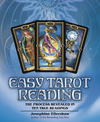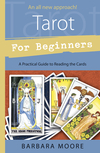Reading Tarot Cards: Divining Our Life Path

From Where Do the Cards of the Tarot Originate?
Mystery shrouds the origin of Tarot cards, but ancient oracle decks have been found in a wide range of places, from Hungary to India to China. Some historical sources credit the traveling, wandering musicians and performers who roamed (originally) from India to Persia to Egypt for carrying cards and methods of divination with them.
Today's standard Tarot decks contain seventy-eight cards: twenty-two Major Arcana cards and fifty-six Minor Arcana cards. The twenty-two Major Arcana include the zero card, The Fool, and then progress through twenty-one archetypes such as the Empress, the Magician, Wheel of Fortune, Judgment, the Tower, the Sun, and the Moon. Each of these major cards indicate a powerful influence moving through one's life, something to which we should pay close attention.
For example, the Tower usually indicates a major life change or breakthrough caused by external circumstances (such as job loss, breakup or divorce, change of location, etc.). Not always negative, though, the Tower card often portrays an all-seeing eye, one that pierces through the changes and gives a glimpse into the long-term future. Knowing when these forces are on the horizon can help us to accept change and growth, and a Tarot reading shows a likely path that is unfolding for the reader.
The Empress is associated with the mother archetype and the Emperor with the father. When one or both of these cards appear in a reading, I ask my client to examine their roles as either mother/father, their relationship to their own parents, and to the deeper patterns in life where these archetypes express themselves.
The remaining fifty-six cards in the Tarot deck comprise the Minor Arcana, which represent more subtle influences that are occurring in our lives (and that are not as dramatic as those represented by the Major Arcana). These cards are divided into four suits, akin to the four suits of playing cards (which are thought to have derived from original Tarot decks). They are pentacles or disks (associated with money/wealth matters), cups (associated with emotions/love), swords (associated with the mind/thoughts), and wands (associated with spiritual matters).
Each of these Minor Arcana contains either a number, such as the Four of Cups or the Ten of Swords, or a Court Card. Court cards vary from deck to deck, but include some version of four people, two men and two women (such as Prince, Princess, Knight, and King). These cards represent people in our lives—such as friends, family, lovers, and colleagues—who influence us in a variety of ways. They may also indicate developmental aspects of ourselves, a personality trait or characteristic to which we should pay attention.
With all of these different elements moving through the deck, we find a rich array of symbolism, themes, archetypes, and numbers with which to work. Combining these images with the placement in a reading (such as the Issue at Hand, External Influences, Possible Outcome) provides us with the message the cards are trying to convey. Although it takes years to master the Tarot, we can begin working with a deck immediately, finding certain qualities to impart meaning. Over time, patterns emerge, showing us how the cards can help to guide us as we approach questions in life.
How Do People Work with the Tarot?
First, we must choose a deck style with which to work. I personally have been using the Aleister Crowley/Thoth deck for the last ten years, and although it took me a long time to learn the cards, it has paid off, as the answers I've received using this deck are very precise. Another popular deck style is the Rider-Waite, which is easy to read, with clear and obvious symbolism. Standard decks are based on one of these two deck styles, and there are hundreds—if not thousands—of other variety decks to choose from as well. Picking one that is based on one of the two standard deck styles will set a solid foundation for reading when you decide to move on to using other decks.
Most querents (the person asking a Tarot reader to interpret the cards) ask questions regarding love and relationships, career and money, and sometimes spirituality and destiny. These are all very useful themes, as the cards can be very specific.
When we want to use the cards, it is best to tune in to our overall focus, whether it is love or career or another topic entirely. As we feel into this, we then must devise a question for the cards. Questions for the Tarot should not be answerable with a "yes" or a "no," but rather should be process questions of "what" or "how." For example, "What do I need to know now about my career?" or "How can I best be available to meet a partner?" or "What should I do about a particular situation?"
Once we have our question, we then lay the cards out. While there are an infinite number of ways to lay out the cards, a six card layout is a simple and effective for answering our questions. The six card placement is as follows:
- Self: This card represents our self and where we are currently.
- Supporting the Issue: This card represents the seen or unseen forces at play that are assisting our situation.
- Issue at Hand: This card indicates the issue or situation we are facing.
- The Deeper Issue: This card represents what is underlying the issue, an even deeper issue that needs to resolved. This card is connected to our subconscious and shadow self.
- Action to Take: This card indicates some outward way to help ourselves work with the issue or situation.
- Possible Outcome: This card indicates where the situation is headed or going, the unfolding events or issues.
When you first begin reading, you may need to rely on an accompanying booklet or, even better, a more in-depth guide or book. However I also recommend looking carefully at each card, noting what jumps out at you, which symbols, colors, or images speak to you. The cards serve as a mirror for your own intuition. Take note of what speaks to you on paper as a reference for your reading.
One way to build your connection with the Tarot and deepen your understanding is to choose one card each day and see how it relates and connects to the unfolding events in your day. I recommend limiting the number of readings for a particular question to one a week (or less), so that you have time to let the answer sink in. Over reading and searching for answers is not helpful and giving yourself time to reflect on a reading may provide insights to rise to the surface. Also, practice reading for others, as that is often easier than reading for yourself (as you are less attached to the outcome).
Reading Tarot is an incredibly useful way to answer life's questions and find guidance. By practicing with a deck, you will open up a deeper connection to your own inner intuition and find a way to reflect on the various issues that arise in your life. From relationships to money questions, to the deeper wondering on life's purpose and destiny, Tarot cards are a wonderful tool.

About Katalin Jett Koda
Related Products


is subject to certain Terms and Conditions